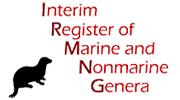Interim Register of Marine and Nonmarine Genera
The Interim Register of Marine and Nonmarine Genera (IRMNG) is a taxonomic database which attempts to cover published genus names for all domains of life from 1753 in zoology (1758 in botany) up to approximately 2014, arranged in a single, internally consistent taxonomic hierarchy, for the benefit of Biodiversity Informatics initiatives plus general users of biodiversity (taxonomic) information. In addition to containing over 490,000 published genus name instances as at March 2020 (also including subgeneric names in zoology), the database holds over 1.7 million species names (1.3 million listed as "accepted"), although this component of the data is not maintained in as current or complete state as the genus-level holdings. IRMNG can be queried online for access to the latest version of the dataset and is also made available as periodic snapshots or data dumps for import/upload into other systems as desired.
 | |
| Abbreviation | IRMNG |
|---|---|
| Formation | 2006 |
| Headquarters | Ostend, Belgium |
Manager & curator | Tony Rees |
Main organ | Website |
Parent organization | Flanders Marine Institute |
| Website | www |
Description
IRMNG contains scientific names (only) of the genus, species, and higher ranks of many plants, animals and other kingdoms, both living and extinct, within a standardized taxonomic hierarchy, with associated machine-readable information on habitat (e.g. marine/nonmarine) and extant/fossil status for the majority of entries.[1] The database aspires to provide complete coverage of both accepted and unaccepted genus names across all kingdoms, with a subset only of species names included as a lower priority. In its March 2020 release, IRMNG contained 492,620 genus names, of which 232,093 were listed as "accepted", 121,389 "unaccepted", 7,462 of "other" status i.e. interim unpublished, nomen dubium, nomen nudum, taxon inquirendum or temporary name, and 131,676 as "uncertain" (unassessed for taxonomic status at this time).[2] The data originate from a range of (frequently domain-specific) print, online and database sources, including (among others) Nomenclator Zoologicus for animals and Index Nominum Genericorum for plants, and are reorganised into a common data structure to support a variety of online queries, generation of individual taxon pages, and bulk data supply to other biodiversity informatics projects. IRMNG content can be queried and displayed freely via the web, and download files of the data down to the taxonomic rank of genus as at specific dates are available in the Darwin Core Archive (DwC-A) format. The data include homonyms (with their authorities), including both available (validly published) and selected unavailable names.[3]
Database location and hosting
IRMNG was initiated and designed by Tony Rees in 2006.[1][4] For his work on this and other projects, GBIF awarded him the 2014 Ebbe Nielsen Prize.[4] From 2006-2014 IRMNG was located at CSIRO Marine and Atmospheric Research, and was moved to the Flanders Marine Institute (VLIZ) over the period 2014–2016; from 2016 onwards all releases have been available via its new website www.irmng.org which is hosted by VLIZ.[1][5] VLIZ also hosts the World Register of Marine Species (WoRMS), using a common infrastructure.[6]
IRMNG usage
Content from IRMNG is used by several global Biodiversity Informatics projects including Open Tree of Life,[7] the Global Biodiversity Information Facility (GBIF),[8] and the Encyclopedia of Life (EOL),[9] in addition to others including the Atlas of Living Australia[10] and the Global Names Architecture (GNA)'s Global Names Resolver.[11] From 2018 onwards, IRMNG data are also being used to populate the taxonomic hierarchy and provide generic names for a range of taxa in the areas of protists (kingdoms Protozoa and Chromista) and plant algae (Charophyta, Chlorophyta, Glaucophyta and Rhodophyta) in the Catalogue of Life.[12] IRMNG identifiers have also been associated with numerous Wikipedia taxon pages, based on content harvested from IRMNG and stored in Wikidata.[13]
References
- "IRMNG - Interim Register of Marine and Nonmarine Genera". IRMNG. Retrieved 23 May 2019.
- "IRMNG - Download". IRMNG. Retrieved 2 April 2019.
- "IRMNG: Homonyms". IRMNG. Retrieved 2018-12-10.
- "CSIRO's Tony Rees named 2014 Ebbe Nielsen Prize winner". GBIF. Retrieved 10 December 2018.
- "The Interim Register for Marine and Nonmarine Genera (IRMNG) will move from CSIRO to VLIZ". marinespecies.org. Retrieved 10 December 2018.
- "Interim Register of Marine and Nonmarine Genera (IRMNG)". Lifewatch regional portal. LifeWatch. Retrieved 10 December 2018.
- Open Tree of Life developers. "Taxonomy release ott3.0 -". Open Tree of Life. Retrieved 10 December 2018.
- "The Interim Register of Marine and Nonmarine Genera". GBIF. 2018. doi:10.15468/6tkudz. Retrieved 10 December 2018.
- "IRMNG". Encyclopedia of Life. Archived from the original on 1 April 2018.
- "AtlasOfLivingAustralia/ala-name-matching". Atlas of Living Australia. Retrieved 18 December 2018.
- "Global Names Resolver: Names Data Sources". Retrieved 18 December 2018.
- "IRMNG". Catalogue of Life. Retrieved 25 July 2020.
- Wikidata: IRMNG ID (P5055)
Further reading
- Rees, Tony (2008). "18.8. IRMNG—the Interim Register of Marine and Nonmarine Genera" (PDF). The Proceedings of TDWG. 2008: 72–73.
- Rees, Tony; Vandepitte, Leen; Decock, Wim; Vanhoorne, Bart (2017). "IRMNG 2006–2016: 10 years of a global Taxonomic Database". Biodiversity Informatics. 12: 1–44. doi:10.17161/bi.v12i0.6522.
- Rees, Tony; Vandepitte, Leen; Vanhoorne, Bart; Decock, Wim (2020). "All genera of the world: an overview and estimates based on the March 2020 release of the Interim Register of Marine and Nonmarine Genera (IRMNG)". Megataxa. 1: 123–140. doi:10.11646/megataxa.1.2.3.